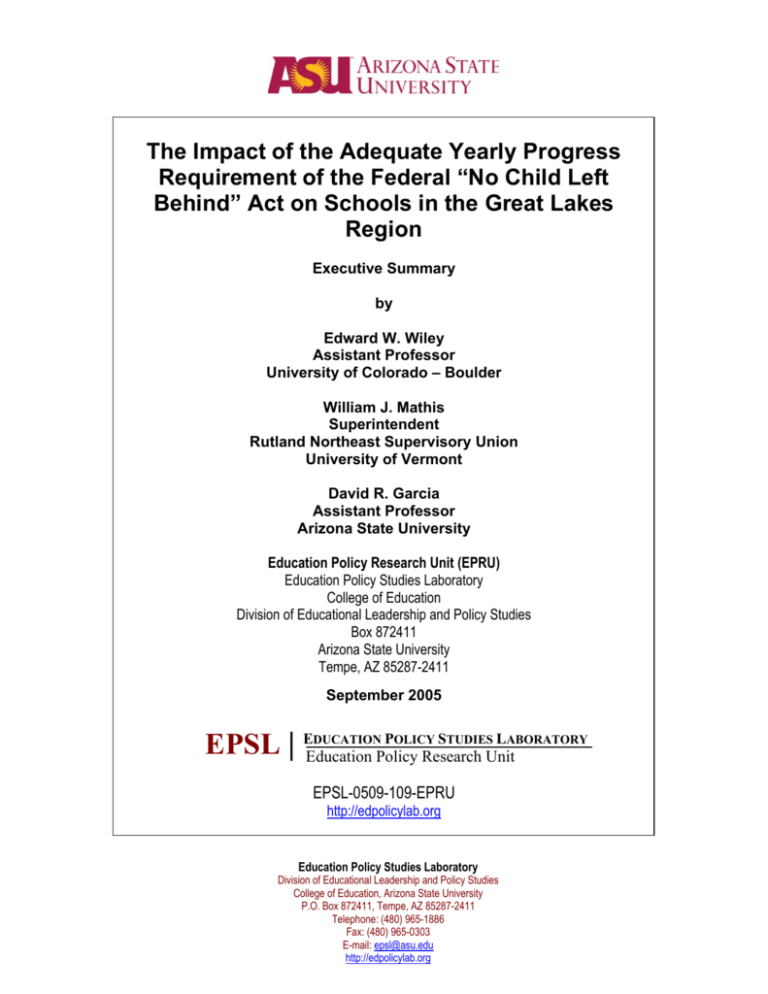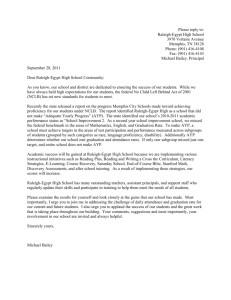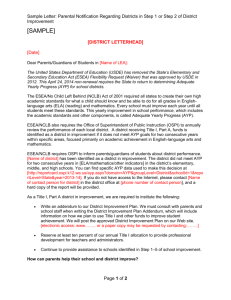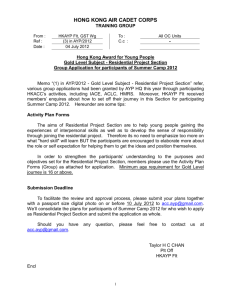The Impact of the Adequate Yearly Progress Requirement
advertisement

The Impact of the Adequate Yearly Progress Requirement of the Federal “No Child Left Behind” Act on Schools in the Great Lakes Region Executive Summary by Edward W. Wiley Assistant Professor University of Colorado – Boulder William J. Mathis Superintendent Rutland Northeast Supervisory Union University of Vermont David R. Garcia Assistant Professor Arizona State University Education Policy Research Unit (EPRU) Education Policy Studies Laboratory College of Education Division of Educational Leadership and Policy Studies Box 872411 Arizona State University Tempe, AZ 85287-2411 September 2005 DUCATION POLICY STUDIES LABORATORY EPSL | EEducation Policy Research Unit EPSL-0509-109-EPRU http://edpolicylab.org Education Policy Studies Laboratory Division of Educational Leadership and Policy Studies College of Education, Arizona State University P.O. Box 872411, Tempe, AZ 85287-2411 Telephone: (480) 965-1886 Fax: (480) 965-0303 E-mail: epsl@asu.edu http://edpolicylab.org This research was made possible by a grant from the Great Lakes Center for Education Research and Practice. The Impact of the Adequate Yearly Progress Requirement of the Federal “No Child Left Behind” Act on Schools in the Great Lakes Region Edward W. Wiley University of Colorado – Boulder William J. Mathis Rutland Northeast Supervisory Union University of Vermont David R. Garcia Arizona State University Executive Summary This study finds that nearly every school in the Great Lakes states is threatened to fail the Adequate Yearly Progress (AYP) requirements mandated by the federal “No Child Left Behind” (NCLB) Act. NCLB holds schools and districts accountable for student achievement on state standardized tests and schools that do not make AYP face sanctions. A school or district can avoid sanctions one of two ways: produce test scores that meet AYP annual objectives set by the state, or by making sufficient improvement over the previous year’s test scores to take advantage of “Safe Harbor” status. The goals of NCLB are deceptively simple: All schools and districts receiving funds for socially and economically deprived children (Title I) must bring all students up to state standards by 2014. The implementation is considerably more complex. The most critical and controversial aspects of NCLB are school accountability policies and AYP requirements. This study examines the implementation of those policies in the Great Lakes states, and projects the percentage of schools that will make or fail to make AYP, and those that could be Safe Harbor eligible: • Illinois is projected, under the best case scenario, to have more than 96 percent of schools fail AYP with 29 percent of schools potentially Safe Harbor eligible in 2014. • Indiana is projected to have 80 to 85 percent of schools eventually fail AYP in 2014, according to the most realistic scenarios. • Michigan is projected to have nearly 50 percent of schools fail to make AYP in 2014, but remain Safe Harbor eligible according to the most forgiving scenario. Still, nearly all of these schools could fail to make AYP outright under the remaining scenarios. • Minnesota is projected to have 81 percent of its schools failing AYP in 2014 but 27 percent of schools could be Safe Harbor eligible. Schools are projected to fail at a consistent rate as the AYP requirements increase annually. • Ohio is projected to have a relatively high percentage of schools make AYP (approximately 85 percent) until 2011, at which point the percentage of schools making AYP drops dramatically to a low point of 12 percent of schools making AYP. Page 2 of 3 This document is available on the Education Policy Studies Laboratory website at: http://www.asu.edu/educ/epsl/EPRU/documents/EPSL-0509-109-EPRU.pdf • Wisconsin is projected to experience the biggest impact in the later years (2011-2014) when 84 percent schools are projected to fail AYP, but 34 percent of schools could be Safe Harbor eligible. In general, approximately 85 percent of schools in the Great Lakes states are projected to fail AYP in 2014 under the most optimistic scenarios. Under more realistic circumstances, the overall failure rate is projected to be at or above 95 percent. In summation, the authors question the sustainability of the AYP requirements. Furthermore, they caution that schools are not capable of closing the achievement gap without resolving the social problems that underlie this gap. They point out that adequate funding for remediation and social infrastructure is essential to meeting the stated goals of NCLB. The projections for the Great Lakes states are applicable to the nation as a whole and are a warning about the sustainability of NCLB, as the AYP requirements are currently constructed. The entire country faces tremendous failure rates, even under a conservative estimate with several forgiving assumptions. Page 3 of 3 This document is available on the Education Policy Studies Laboratory website at: http://www.asu.edu/educ/epsl/EPRU/documents/EPSL-0509-109-EPRU.pdf



